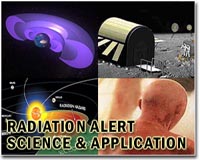 |
Geneva (AFP) April 13, 2011 The World Health Organisation is seeking studies for up to 20 years to keep watch over public health in Japan following the Fukushima nuclear emergency, a senior official said on Wednesday. WHO environmental health chief Maria Neira played down a current risk to public health outside the 30-kilometre exclusion zone around the Fukushima Daiichi plant, based on tests and monitoring by Japanese authorities. "There is no need for new public health measures," Neira told journalists. She nonetheless underlined that the UN health agency could not let its guard drop while the radiation emergency at the plant was underway, as the WHO maintained permanent monitoring with the Japanese and global detection networks. "This is an evolving situation and we need to assess and reassess almost on a one-hour basis, because the situation is unfortunately not yet under control and we do not know what might happen," Neira told journalists. "Obviously we continue to be very vigilant, we never came down our level of alert, and we continue to monitor in a very careful way how the situation is moving; our assessment might change in one hour, I don't know," Neira told journalists. Japan upgraded its month-old nuclear emergency on Tuesday to a maximum seven on an international scale of atomic crises, placing it on a par with the Chernobyl disaster a quarter-century ago. The WHO understood that the change was not made because of public health concerns, Neira said. "It's clear that this 30-kilometre area provides the best shield for the protection of the population," she added, while emphasising that the WHO was also starting to consider potential future health consequences of the emergency. "We need to start to put the basis for the studies that need to be conducted for the next 10 to 20 years," the WHO director of public health and environment said. "It may be too early because we are still in the very acute phase of detection for human health but we are discussing with Japan." Japanese authorities have screened thyroid functions in more than 940 children, with the results "all under the dose that represent risk," she emphasised.
earlier related report "It is hard for me to assess why the Japanese colleagues have taken this decision," Sergei Kiriyenko, the head of Russia's state nuclear agency Rosatom, told reporters in the southern Chinese city of Sanya on the eve of the BRICS summit. "I suspect this is more of a financial issue than a nuclear one." Earlier this week Japan upgraded its month-old nuclear emergency to a maximum seven on an international scale of atomic crises, placing it on a par with the Chernobyl disaster in 1986. Kiriyenko appeared to suggest that the Japanese authorities were seeking to reduce the burden on insurance companies. "I guess that maybe it could be linked to the definition of force majeure with regards to insurance? I would pay attention to that. It is a bit strange," Kiriyenko said. Kiriyenko said at first the Japanese authorities had thought to downplay the scale of the disaster but now the situation at the plant was improving. "Our estimates have shown that the level was between five and six," Kiriyenko said. "Today it doesn't reach the sixth level." France's nuclear safety agency also said this week that the impact of the Fukushima accident was not comparable to the Chernobyl disaster. Fukushima has had three reactors that have hit problems, compared with one at Chernobyl. But the Japanese plant has released only one-tenth of the radioactivity disgorged by Chernobyl because its reactor vessels have so far remained intact, thus keeping almost all of the nuclear fuel enclosed. The previous rating of five had placed the unfolding disaster at the tsunami-hit Fukushima plant northeast of Tokyo on the same level as the 1979 Three Mile Island accident in the US state of Pennsylvania. Level seven of the UN's International Nuclear Events Scale describes events with "major release of radioactive material with widespread health and environmental effects, requiring implementation of planned and extended countermeasures."
Share This Article With Planet Earth
Related Links Space Technology News - Applications and Research
 EPA, NRC checking for Japanese radiation
EPA, NRC checking for Japanese radiationWashington (UPI) Apr 12, 2011 Miniscule amounts of radiation from Japan's nuclear emergency have reached the United States but Environmental Protection Agency Administrator Lisa Jackson assured U.S. lawmakers Tuesday that those amounts were well-monitored and far below dangerous levels. Jackson told the U.S. Senate Committee on Environment and Public Works that radioactive material in the United States in the afterm ... read more |
|
| The content herein, unless otherwise known to be public domain, are Copyright 1995-2010 - SpaceDaily. AFP and UPI Wire Stories are copyright Agence France-Presse and United Press International. ESA Portal Reports are copyright European Space Agency. All NASA sourced material is public domain. Additional copyrights may apply in whole or part to other bona fide parties. Advertising does not imply endorsement,agreement or approval of any opinions, statements or information provided by SpaceDaily on any Web page published or hosted by SpaceDaily. Privacy Statement |